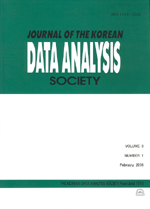헤지의 표준화된 평균차를 이용한 청국장의 항-고지혈증 메타분석
The Meta Analysis for Anti-hyperlipidemia Effect of Cheonggukjang Using Hedges’ Standardized Mean Difference
- 한국자료분석학회
- Journal of The Korean Data Analysis Society (JKDAS)
- Vol.14 No.5
-
2012.102417 - 2427 (11 pages)
- 5

본 연구는 헤지의 표준화된 평균차를 이용한 메타분석을 통해 청국장을 섭취한 고지혈증유발 실험쥐들의 혈중콜레스테롤, 혈중중성지방, 동맥경화지수, 간 콜레스테롤, 간 중성지방 수치의 표준화된 평균차를 통해 청국장의 항-고지혈증 효과를 알아보고자 하였다. 동질성검정을 통해 모든 변수에서 이질성을 확인하여 랜덤효과모형으로 분석한 결과 청국장을 섭취한 후 실험쥐들의 혈중콜레스테롤, 혈중중성지방, 동맥경화지수, 간 콜레스테롤, 간 중성지방이 통계적으로 유의하게 감소한 것을 알 수 있었다. 또한 이질성의 원인을 파악하기 위해 청국장 섭취기간과, 섭취량을 고려하여 분석한 결과 혈중콜레스테롤과 동맥경화지수는 청국장을 섭취한 기간과 섭취량 모두 영향을 받았고, 혈중중성지방과 간 중성지방은 청국장을 섭취량에만 영향을 받았다.
This study was carried out to summarize the effect of cheonggyukjang in the hyperlipidemia rats by meta-analysis related studies. The association measure to test effect of cheonggyukjang was the Hedges’ standardized mean difference (HG). The case of heterogenous variable such as serum cholesterol, serum triglyceride, atherosclerotic index, liver cholesterol, liver triglyceride, random effect model was applied. In random effect model, serum cholesterol, serum triglyceride, atherosclerotic index, liver cholesterol, liver triglyceride were decreased significantly in cheonggyukjang treated group. According to the meta-regression analysis, intake period and the amount of intake were significant for serum cholesterol and atherosclerotic index. Also the amount of intake was significant for serum triglycerid and liver triglyceride.
1. 서론
2. 사례연구
3. 결론
참고문헌
(0)
(0)